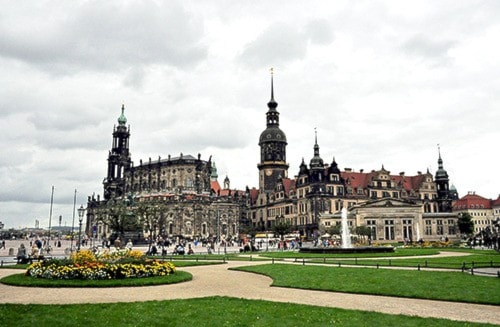Dresden, Saxony: With the River Elbe to my left and the reconstructed historic city of Dresden below, I stand on the massive city wall wondering: “How on earth did they manage to rebuild this city? And, how much did it cost?”
The cost, of course, has to be measured not only in cash, but in lives, determination, pride, and support from former enemies who are now firm friends.
Decimated by the Seven Years War in the 1700s, and destroyed again in 1945 by 650,000 bombs in retaliation for Germany’s attack on Britain’s Coventry, this city has consistently, literally, risen from the ashes.
The Dresden Frauenkirche (Church of Our Lady) is, perhaps, the profile to ponder. Built in the 18th century, it lay in an unsightly city centre heap of rubble throughout “former times’ – Communist rule.
After German unification in 1990 the Baroque structure was reconstructed as a symbol of reconciliation with the support of former enemies, historic architectural plans, and much of the stone from the ruins of the original building. This testament to peace took 13 years to build. It was reconsecrated on Protestant Day of Reformation, Oct. 31, 2005.
Noted throughout history for its arts, culture, and technology, Dresden is again a prime tourist destination. My hotel, the new Swissotel Dresden Am Schloss, is ‘sold out’ again this week. A very good year, the manager tells me.
Just steps from Frauenkirche, the Semper Opera, the Zwinger Palace, and close to enough shopping to suit any price, the hotel’s preserved Baroque schloss façade blends with local architecture. But, the surprise lurks in the basement. During construction a 15th century stone cellar was unearthed. It now houses the hotel spa, and is perfect for rejuvenating my aching muscles after days of clambering on and off trains, planes, and automobiles.
 Although not part of my two-day Dresden Pass, I’ve been told a stop at the Neues Grünes Gewölbe, or the New Green Vault, is a ‘must’.
Although not part of my two-day Dresden Pass, I’ve been told a stop at the Neues Grünes Gewölbe, or the New Green Vault, is a ‘must’.
[Dresden stollen: a treat at Christmas]
A quick visit, I think, since it’s just blocks away upstairs in Dresden Castle. I’m surprised that admission booking times are mandatory – until I experience the no-nonsense security which includes synchronized steel doors. Airport security has nothing on this.
Once inside, I realize it is indeed a massive vault housing treasures dating back to 1547, but which were assembled in the 18th century by Augustus the Strong as a private treasure chamber for the rulers of Saxony.
Named after malachite stone columns in the original severely bomb damaged vault, more time than expected passes. I wander through the rooms admiring the jewels and workmanship, before one gleaming steel door after another firmly shuts me out.
 En route to dinner I’m side tracked by the Meissen shop. This is the 300th anniversary of the delicate porcelain. Thanks to Augustus the Strong’s passion for porcelain, but lack of funds to import what he wanted, he imported the artist instead.
En route to dinner I’m side tracked by the Meissen shop. This is the 300th anniversary of the delicate porcelain. Thanks to Augustus the Strong’s passion for porcelain, but lack of funds to import what he wanted, he imported the artist instead.
Follow the Cloverdale Reporter on  Twitter and
Twitter and ![]() Facebook. View our print edition online.
Facebook. View our print edition online.
[left: Meissen porcelain cup]
Luring Johann Friedrich Böttger, an alchemist and apothecary, to Dresden, Augustus funded a lab for the 19-year-old deep within the city’s fortifications – far from the clutches of the King of Prussia, who was also pursuing the young science wizard.
Thanks to Böttger’s brains, and Augustus’ entrepreneurship, white porcelain was developed, and in January, 1710 August announced the establishment of a porcelain manufactory.
Admiring the delicate elegantly painted pieces, I resist the urge to buy a chocolate pot, tea pot, or the little chocolate server figurine. After all, schnitzel awaits on the Brühlsche Terrasse – beneath which Joseph’s lab was once hidden.
Fortified by a glass of Riesling, I admire the early evening river boats depart for local villages, and the Czech border which is only a couple of hours away.
Dresden, and surrounding areas, requires more than my rushed 48 hours. Clearly others walking and biking, or tram-riding, through the old city agree. For late autumn, the weather is warm. I reflect on the rewards of friendship versus the devastation of war.
Then, I remember – Dresden Stollen! I forgot to buy some of the famous sweet bread laced with raisins soaked in spiced Jamaican rum, candied lemon and orange peel. A large loaf weighed a ton (slight exaggeration), but the half-size well packed will travel satisfactorily. Do I have room? I make a note to dash out before departure. After all, Christmas is coming. A sign next to traditional sweet said so …only 53 days to go. Suddenly, I yearn to return for the magical German Christmas markets. The wooden toys in the gift store will have to do.
It’s a pleasure to have the opportunity to finally enjoy East Germany. My last trip to area was before the Wall came down. Recalling a dismal East Berlin, I reflect on the changes and foresight generated by unification.
Tomorrow, I drive to the nearby spa town of Bad Schandau through what is known as the Switzerland of Saxony…but, first, the Dresden Stollen!
– Ursula Maxwell-Lewis is the founding editor/publisher of the Cloverdale Reporter. Follow her adventures on Twitter @YouTravel.
